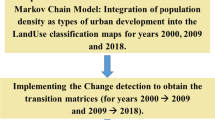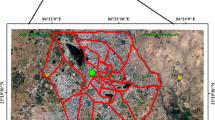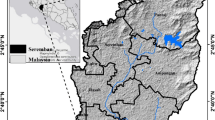Abstract
Urbanization is a blooming phenomenon by which towns and cities are becoming larger as more population is concentrating upon them which results in expansion of the settlements both vertically and horizontally. This creates urban sprawl which is one of the most contrasting feature of unplanned urban growth. This unanimous expansion creates problem in identifying urban administrative boundaries and it also puts pressure and stress on natural environment. The fast growing urban areas need to be observed to ensure a sustainable urban dwelling in the upcoming days. Here GIS and RS are an important and effective monitoring tools in urban planning as well as in decision making. Siliguri and adjacent area is facing the problem of rapid land use transformation, because from its inception Siliguri has flourished as a big urban centre which expanded considerably with the sands of time. The present study employs Markov Chain model as the tool for the spatial distribution of urban land use through tracing the temporal changes over the years. The study is also associated with predicting the future urban growth through several driving variables. Simulated maps show that from 2000 to 2040, there will be continuous decrease in the croplands and forest area, besides it has been observed that the built up area is consequently increased from 31 km2 in 2000 to 98 km2 in 2040. This depicts the problem of urban sprawl beside the existing administrative boundary of Siliguri. Modelling suggests a clear image of land use transformations and built up expansion. It reveals that cropland and open lands were mostly encroached by the urban built-up area and concluded that RS and GIS can be an effective tool for urban policy makers and planners to ensure a sustainable urban dwelling.










Similar content being viewed by others
References
Albizua L, Donezar U, Ibáñez JC (2012) Monitoring urban development consolidation for regional management on water supply using remote sensing techniques. Eur J Remote Sens 45(1):283–292. https://doi.org/10.5721/EuJRS20124525
Bhatta B (2009) Analysis of urban growth pattern using remote sensing and GIS: a case study of Kolkata India. Int J Remote Sens 30(18):4733–4746
Bhattacharyya DB, Mitra S (2013) Making Siliguri a walkable city. Procedia 96:2737–2744
Cabral P, Zamyatin A (2009) Markov processes in modeling land use and land cover changes in Sintra-Cascais Portugal. Dyna 76(158):191–198
Chauvin Y, Rumelhart DE (2013) Backpropagation: theory, architectures, and applications. Psychology Press, East Sussex
Cheng S, Ding N (2016) Land change modeler application: summer internship with Clark labs.
Dadhich PN, Hanaoka S (2010) Remote sensing, GIS and Markov’s method for land use change detection and prediction of Jaipur district. J Geomat 4(1):9–15
Deng JS, Wang K, Hong Y, Qi JG (2009) Spatio-temporal dynamics and evolution of land use change and landscape pattern in response to rapid urbanization. Landsc Urban Plan 92(3):187–198. https://doi.org/10.1016/j.landurbplan.2009.05.001
Dewan AM, Yamaguchi Y (2009) Land use and land cover change in Greater Dhaka, Bangladesh: Using remote sensing to promote sustainable urbanization. Appl Geogr 29(3):390–401
Eastman JR (2012) IDRISI Selva manual. Clark labs-Clark University, Worcester
Foody GM (1992) On the compensation for chance agreement in image classification accuracy assessment. Photogramm Eng Remote Sens 58(10):1459–1460
Gong W, Yuan L, Fan W, Stott P (2015) Analysis and simulation of land use spatial pattern in Harbin prefecture based on trajectories and cellular automata—Markov modelling. Int J Appl Earth Obs Geoinf 34:207–216. https://doi.org/10.1016/j.jag.2014.07.005
Guan D, Gao W, Watari K, Fukahori H (2008) Land use change of Kitakyushu based on landscape ecology and Markov model. J Geog Sci 18(4):455–468
Gupta K, Kumar P, Pathan SK, Sharma KP (2012) Urban Neighborhood Green Index—a measure of green spaces in urban areas. Landsc Urban Plan 105(3):325–335
Gurram MK (2016) Urban Environmental Quality Assessment at Ward Level using AHP based GIS Multi-Criteria Modeling—a study on Hyderabad City, India. Asian J Geoinform 15(3)
He C, Okada N, Zhang Q, Shi P, Zhang J (2006) Modeling urban expansion scenarios by coupling cellular automata model and system dynamic model in Beijing China. Appl Geogr 26(3–4):323–345
Hegazy IR, Kaloop MR (2015) Monitoring urban growth and land use change detection with GIS and remote sensing techniques in Daqahlia governorate Egypt. Int J Sustain Built Environ 4(1):117–124
Huang W, Liu H, Luan Q, Bai M, Mu X (2008) Monitoring urban expansion in Beijing, China by multi-temporal TM and SPOT images. In: IGARSS 2008–2008 IEEE International Geoscience and Remote Sensing Symposium (Vol. 4). IEEE, pp IV-695
Jensen JR (1996) Introductory digital image processing: a remote sensing perspective, 2nd edn. Prentice-Hall Inc., Upper Saddle River
Kityuttachai K, Tripathi NK, Tipdecho T, Shrestha R (2013) CA-Markov analysis of constrained coastal urban growth modeling: Hua Hin seaside city Thailand. Sustainability 5(4):1480–1500
Knorn J, Rabe A, Radeloff VC, Kuemmerle T, Kozak J, Hostert P (2009) Land cover mapping of large areas using chain classification of neighboring Landsat satellite images. Remote Sens Environ 113(5):957–964
Kumar S, Radhakrishnan N, Mathew S (2014) Land use change modelling using a Markov model and remote sensing. Geomat Nat Hazards Risk 5(2):145–156
Li X, Yeh AGO (2002) Neural-network-based cellular automata for simulating multiple land use changes using GIS. Int J Geogr Inf Sci 16(4):323–343
Li L, Sato Y, Zhu H (2003) Simulating spatial urban expansion based on a physical process. Landsc Urban Plan 64(1–2):67–76
Liu L, Wang Z, Zhang H (2017) Neural-network-based robust optimal tracking control for MIMO discrete-time systems with unknown uncertainty using adaptive critic design. IEEE Trans Neural Netw Learn Syst 29(4):1239–1251
Logsdon MG, Bell EJ, Westerlund FV (1996) Probability mapping of land use change: a GIS interface for visualizing transition probabilities. Comput Environ Urban Syst 20(6):389–398
Ma Z, Redmond RL (1995) Tau coefficients for accuracy assessment of classification of remote sensing data. Photogramm Eng Remote Sens 61(4):435–439
Maithani S (2010) Cellular automata based model of urban spatial growth. J Indian Soc Remote Sens 38(4):604–610
Mondal B, Das DN, Dolui G (2015) Modeling spatial variation of explanatory factors of urban expansion of Kolkata: a geographically weighted regression approach. Model Earth Syst Environ 1(4):29
Musa SI, Hashim M, Reba MNM (2017) A review of geospatial-based urban growth models and modelling initiatives. Geocarto Int 32(8):813–833
Nazarnia N, Schwick C, Jaeger JAG (2016) Accelerated urban sprawl in Montreal, Quebec City, and Zurich: investigating the differences using time series 1951–2011. Ecol Ind 60:1229–1251. https://doi.org/10.1016/j.ecolind.2015.09.020
Nkeki FN (2016) Spatio-temporal analysis of land use transition and urban growth characterization in Benin metropolitan region, Nigeria. Remote Sens Appl Soc Environ 4:119–137
Pijanowski BC, Brown DG, Shellito BA, Manik GA (2002) Using neural networks and GIS to forecast land use changes: a land transformation model. Comput Environ Urban Syst 26(6):553–575
Rahman MT (2016) Detection of land use/land cover changes and urban sprawl in Al-Khobar, Saudi Arabia: an analysis of multi-temporal remote sensing data. ISPRS Int J Geo-Inform 5(2):15
Samat N, Hasni R, Elhadary YAE (2011) Modelling land use changes at the peri-urban areas using geographic information systems and cellular automata model. J Sustain Dev 4(6):72. https://doi.org/10.5539/jsd.v4n6p72
Shafizadeh-Moghadam H, Asghari A, Tayyebi A, Taleai M (2017) Coupling machine learning, tree-based and statistical models with cellular automata to simulate urban growth. Comput Environ Urban Syst 64:297–308
Shaw A (2013) Emerging perspective on small cities and towns. In: Sharma RN, Sandhu RS (eds) Small cities and towns in global era: emerging changes and perspectives. Rawat Publications, Jaipur, pp 36–53
Silva EA, Clarke KC (2002) Calibration of the SLEUTH urban growth model for Lisbon and Porto, Portugal. Comput Environ Urban Syst 26(6):525–552
Sisodia PS, Tiwari V, Kumar A (2014) Analysis of supervised maximum likelihood classification for remote sensing image. In: International conference on recent advances and innovations in engineering (ICRAIE-2014). IEEE, pp 1–4
Tayyebi A, Pijanowski BC, Tayyebi AH (2011) An urban growth boundary model using neural networks, GIS and radial parameterization: an application to Tehran Iran. Landsc Urban Plan 100(1–2):35–44
Thapa RB (2009) Spatial process of urbanization in Kathmandu valley Nepal. University of Tsukuba Graduate School of Life and Environmental Sciences, University of Tsukuba, Japan, p 153
United Nations, Department of Economic and Social Affairs, Population Division (2015). World Urbanization Prospects: The 2014 Revision, (ST/ESA/SER.A/366).
Vaz E, Nijkamp P (2015) Gravitational forces in the spatial impacts of urban sprawl: an investigation of the region of Veneto, Italy. Habitat Int 45:99–105
Wilson JS, Clay M, Martin E, Stuckey D, Vedder-Risch K (2003) Evaluating environmental influences of zoning in urban ecosystems with remote sensing. Remote Sens Environ 86(3):303–321
Yang X, Zheng XQ, Lv LN (2012) A spatiotemporal model of land use change based on ant colony optimization, Markov chain and cellular automata. Ecol Model 233:11–19. https://doi.org/10.1016/j.ecolmodel.2012.03.011
Zhang H, Wang Z (2009) New delay-dependent criterion for the stability of recurrent neural networks with time-varying delay. Sci China Ser F: Inform Sci 52(6):942–948
Zhang R, Tang C, Ma S, Yuan H, Gao L, Fan W (2011) Using Markov chains to analyze changes in wetland trends in arid Yinchuan Plain China. Math Comput Model 54(3–4):924–930
Zhang W, Li W, Zhang C, Ouimet WB (2017) Detecting horizontal and vertical urban growth from medium resolution imagery and its relationships with major socioeconomic factors. Int J Remote Sens 38(12):3704–3734
Zhu J, Tian S, Tan K, Du P (2016) Human settlement analysis based on multi-temporal remote sensing data: a case study of Xuzhou City China. Chin Geogr Sci 26(3):389–400
Acknowledgements
The authors would like to express cordial thanks to our respected teachers of Department of Geography & Applied Geography, University of North Bengal, who have always been mentally, economically and infrastructurally supported ourselves. At last, authors would like to acknowledge all of the agencies and individuals specially, USGS for obtaining the maps and data required for the study and Sri Biswajit Kundu & Sri Arup Ghosh for providing drone images required for the study.
Funding
The authors declare that the study has no funding.
Author information
Authors and Affiliations
Corresponding author
Ethics declarations
Conflict of interest
The authors declare that they have no conflicts.
Additional information
Publisher's Note
Springer Nature remains neutral with regard to jurisdictional claims in published maps and institutional affiliations.
Rights and permissions
About this article
Cite this article
Bose, A., Chowdhury, I.R. Monitoring and modeling of spatio-temporal urban expansion and land-use/land-cover change using markov chain model: a case study in Siliguri Metropolitan area, West Bengal, India. Model. Earth Syst. Environ. 6, 2235–2249 (2020). https://doi.org/10.1007/s40808-020-00842-6
Received:
Accepted:
Published:
Issue Date:
DOI: https://doi.org/10.1007/s40808-020-00842-6




